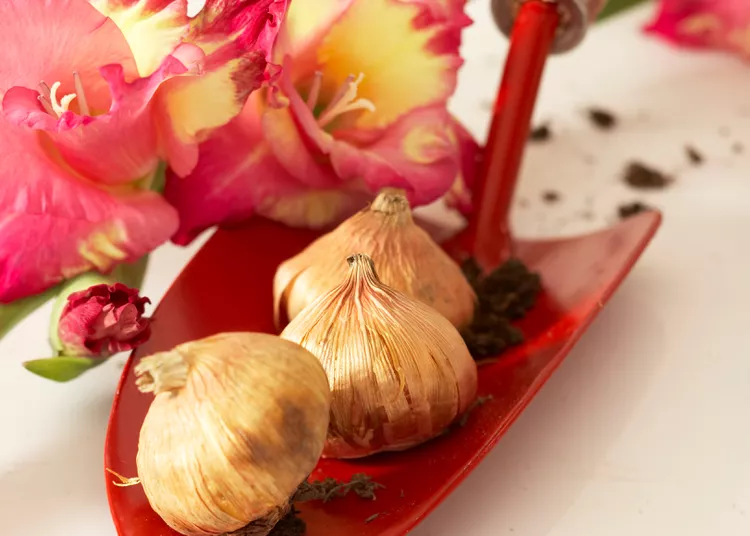Knowing how and when to plant gladiolus bulbs is key to successfully growing these beautiful perennial flowers in your garden. Gladiolus varieties come in a range of hues, and some can grow up to 5 feet tall. But first you have to start with the small, plain-looking bulbs. This guide provides step-by-step instructions for planting gladiolus bulbs, and provides essential tips on choosing the best types to plant, site preparation, and what to do with the bulbs before winter.
Gladiolus bulbs are not actually true bulbs like tulips and daffodils. Botanically they are called ”corms,” which are structured differently than true bulbs. Both types of underground storage organs are treated similarly in gardens, so for simplicity, this article will just use the term "bulb."
Choosing Gladiolus Bulbs
Buying gladiolus bulbs from a reputable online garden shop or local nursery is an excellent option to ensure you get high-quality bulbs. You'll also find a wider selection of varieties to choose from than you might at a brick-and-mortar store. There are plenty of varieties of gladiolus to plant in your garden, but here are a few popular ones to look for:
- ‘Black Beauty’ is a sought-after choice for its dark red flowers and the four-week blooming time. These flowers attract hummingbirds and are deer-resistant. The stunning flower stalks are especially striking in cut flower arrangements. It blooms from mid-summer to frost.
- ‘Priscilla’ produces tri-colored flowers in white, pastel yellow, and pink hues. It's easy to maintain and makes an excellent cut flower. It blooms all summer and is a favorite of hummingbirds and butterflies.
- ‘Yellowstone’ has bright yellow flowers on 5-foot-tall stalks. The cheerful blooms are long-lasting as cut flowers and stand-out in the back of a garden bed.
Preparing the Planting Site
Gladiolus bulbs need full sun, so plant them in an area that receives six to eight hours of sunlight daily. Plant them in well-draining soil that is amended with compost. Compost adds nutrients to the soil and helps retain moisture. Consider growing gladiolus in raised beds if you have heavy or clay soil. Prepare the soil by turning it over and loosening it. Add a couple of inches of compost and mix it in.
When to Plant Gladiolus Bulbs
Gladiolus bulbs are planted in spring after the last possible frost in your area. The soil should be around 55°F. If you plant when the soil is too cold, the bulbs may rot before they have a chance to sprout.
Planting Steps
Before planting, inspect the bulbs you have to ensure they look healthy and are free of disease or pests. Toss out any bulbs that are soft or damaged. To plant your healthy gladiolus bulbs, follow these steps:
- Dig a small hole about 4 inches deep into the soil.
- Place one bulb, pointed side up, into the hole.
- Fill in the hole with the soil you removed.
- Repeat this process until all your bulbs are planted, making sure to space the bulbs 6 to 8 inches apart.
- Water the soil thoroughly after the gladiolus bulbs are planted.
- Apply a 2-inch layer of mulch over the planted bulbs to help keep moisture in the soil and suppress weeds.
Tips for Planting Gladiolus Bulbs
Gladiolus look best when planted in groups of 10 or more bulbs. Different varieties bloom a different times in the season, and some are done after a couple of weeks, while others continue to bloom through the summer. To extend the period of time when you will have glads blooming in your garden, choose varieties that have different seasons of bloom, and plant more groups of bulbs every two weeks into early summer.
Storing Gladiolus Bulbs for Winter
In general, gladioli are winter hardy in USDA Zones 8–10, and can be left in the ground in these regions. But if you live in a colder climate, plan to lift gladiolus bulbs from the ground at the end of summer or in early fall to store them over the winter.
You’ll know the bulbs are ready to be removed when the foliage begins to turn yellow. Carefully dig out the bulbs and shake or brush off any excess soil. Cut off the leaves and stem about an inch above the bulb, and let the bulb dry for a couple of weeks in a dry, ventilated area. The temperature should be around 60°F to 70°F.
When the bulbs are dry, place them in a mesh bag so air flows easily around them. Store them in a cool, dry, dark area so they stay dormant until you’re ready to plant them in the spring. A basement. garage, or root cellar may provide the ideal place to store gladiolus bulbs for the winter.




















